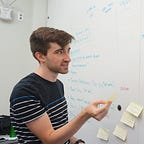Facing the Unknown: Planning Research
Setting a course for team numo’s Capstone research strategy
The great Karen Berntsen has instructions for facing difficult unknowns. Take a problem. Look at the problem closely. Put your hands on your head. Then, shake your head side-to-side. And say, “I don’t know.”
Admitting you don’t know — that you couldn’t possibly know — everything at the start of a project is humbling. Maybe you think you’re an expert in the domain. Maybe your gut defensively yells out assumptions. You find yourself reflexively reaching for your default method or strategy. “Let’s just do a few interviews.” Or perhaps you know absolutely nothing, and struggle to consider even the first step forwards.
But Karen’s exercise is a call for purposeful pause.
You have to stop and admit that you just don’t know. The purpose and joy of research is to continually start with a clean slate and just learn.
Challenge Accepted
After kickoff, we were full of energy. We finally had a clearer vision of scope and client expectations! After two weeks of wondering exactly how we would narrow focus and what numo expected, we could finally start the project.
We were challenged to design something to bridge student career knowledge with high-demand future jobs. While the solution is geared towards middle- and high-schoolers, the design could target students or an influence in their life that would make the most impact.
Question Creation 2: The Sequel
To help jump-start the research process as a group, we held another question creation workshop. We needed to get on the same page on the breadth of research topics, important clusters, and priorities.
Each team member created a list of ten or so questions on post-its, then we each took turns placing them on the white board. Post-its were grouped as we went, then organized into hierarchies.
Our activity generated dozens of questions and a few research gaps. We organized them into themes such as stakeholder experiences, outside considerations, and guiding questions.
Our three major questions guiding the project are:
- What needs of students should our design address? (in the career development domain)
- Which students should the design target to create the most worthwhile change?
- Which user (student or otherwise) should the design target in order to most effectively address those student needs?
Not “Boiling the Ocean”: A Preliminary Research Plan
Although our clients began narrowing our scope during kick-off, our question exercise showed we still had a huge domain to tackle. We soon felt like this “scope” was more of an enormous problem space, as if we had gone back to square one.
“Paralysis” was a word thrown around, how could we possibly start? We needed to hone in, to not try and change everything and “boil the ocean”, as numo told us. How could we efficiently narrow within a short amount of time, while still doing our due diligence?
Timeboxing
Mapping out a timeline helped us narrow to specific research milestones. In a little under three weeks, we needed to find several scoped “areas of opportunities.” We planned on a few in-between steps of narrowing towards specific students and needs. Next week, we wanted to start making decisions and justifications for narrowing our student audience.
Our Research Plan
Nathan drafted a long-term preliminary research plan and compiled our list of questions in a living Google Sheet. Later that day, we went over the research plan and created a short-term plan of attack for the next week including recruiting strategies spearheaded by Alexis.
Since we couldn’t get in to school for at least another month, we decided to start with preliminary interviews with a wide variety of students and their influencers, hopefully from a diversity of backgrounds.
Our ambitious goal was to get close to 16 interviews and hold a synthesis activity to begin narrowing down on stakeholder issues and audiences. We still felt behind after our late kickoff!
Group Check-in the Starfish Way
At the end of the week, we held our first group check-in. Using a “starfish” exercise” we discussed what we could start and stop doing as a group. It really helped us open up about ways to constructively build our team.
Next up: Our first week of research in action!
